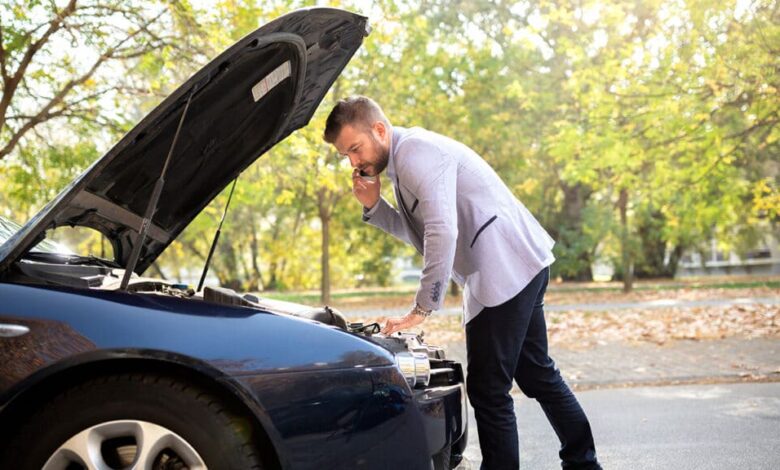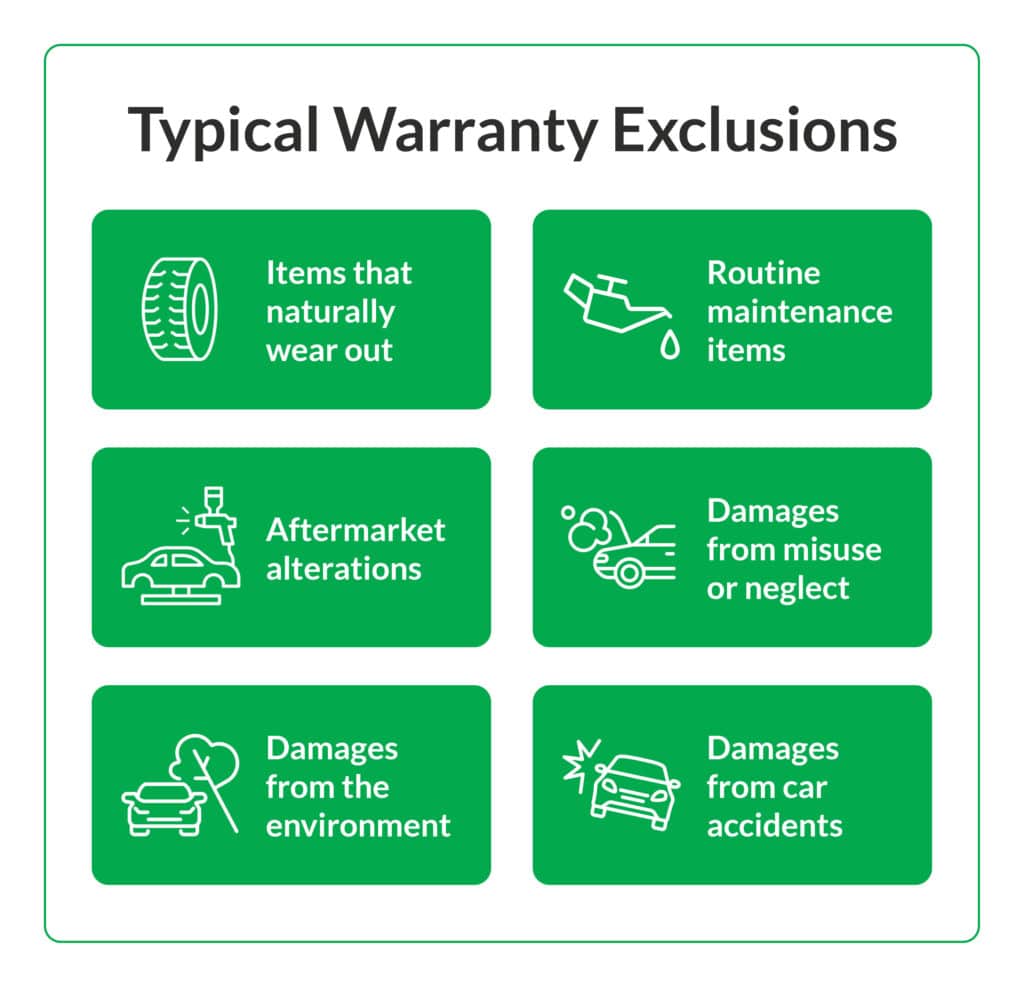Best Extended Car Warranty, Reviewed By Experts (2024)

Extended Car Warranty Coverage
Extended warranties cover major mechanical repairs and replacements for parts that break down over time as a result of normal use. Examples include your air conditioning blowing warm air, an alternator failing or the fuel system not providing the right mix of fuel and air. Some aftermarket contracts include prepaid maintenance or tire protection as well, but these are less common.
Types of Extended Auto Warranty Plans
The specific parts and repairs covered in your extended warranty depend on what coverage level you choose. The three main types of extended warranty coverage plans are bumper-to-bumper, stated-component and powertrain.
Bumper-to-Bumper Warranty
These top-tier contracts are also referred to as exclusionary coverage plans because they cover nearly all of a car’s components from the front bumper to the rear, with the exception of a few named exclusions. These exclusions will vary from company to company but typically include wear-and-tear items like brakes and tires. Bumper-to-bumper warranties are most similar to your original manufacturer’s warranty.
Bumper-to-bumper warranties are best for: Owners of newer used cars who want to keep coverage similar to their factory warranties, drivers who don’t mind paying more for a more worry-free car ownership experience
Stated-Component Warranty
Mid-tier plans are often referred to as stated or named-component coverage because they are inclusionary — meaning they cover only the specific components named in the contract. Coverage for these plans varies between providers and some providers have multiple levels of stated-component coverage.
Stated-component warranties are best for: Owners of cars that don’t qualify for bumper-to-bumper plans but want the maximum coverage available, drivers who want to have concerns about systems or components in their vehicles not covered by lower-tier plans
Powertrain Warranty
The lowest-tier plans offered by warranty providers are typically referred to as powertrain warranties. These plans only cover the components that allow a car to be driven, such as the engine, transmission and drive axles.
Powertrain warranties are best for: Owners of older high-mileage vehicles, drivers who only want to cover the most essential parts of their cars to keep them on the road
What an Extended Car Warranty Doesn’t Cover
While specific coverage varies from one provider to the next, there are certain parts that almost every extended warranty plan leaves out. For the most part, extended warranties won’t cover any routine maintenance or wear and tear items. A comprehensive list of the most common exclusions are:
- Wear and tear items: Brake pads, rotors, windshield wiper blades and inserts, tires, hoses, spark plugs, filters, bulbs, belts and other items that need regular replacement are rarely covered, even by the best extended car warranty plans.
- Routine maintenance: Most warranties don’t cover services like oil changes, alignments and tire rotations that are part of your regular maintenance schedule.
- Collision damage: Damage that comes as a result of an auto accident falls under the responsibility of your car insurance company and is not typically covered by an extended auto warranty plan.
- Damage from neglect: Failing to follow your manufacturer’s suggested maintenance schedule could void your warranty coverage.
- Damage from misuse: If your car breaks down as a result of using it in reckless ways like street racing or towing over capacity, your coverage plan won’t pay for repairs.
- Damage from modifications: Most warranty plans won’t cover damages caused by unauthorized aftermarket parts or modifications you’ve made to the vehicle.
- Environmental damage: Corrosion and other damages caused by weather or other environmental factors are not typically covered by an extended car warranty.
- Incidental damage: Damages caused by theft, vandalism, fire or sources other than normal mechanical failure won’t usually be covered by an auto warranty provider. These repairs are instead typically covered under a comprehensive auto insurance policy.

What Repair Shops Take Extended Car Warranties?
If you experience a mechanical breakdown, like an air conditioning failure or transmission malfunction, you’ll need to take your vehicle to an in-network repair facility. Most warranty providers offer roadside assistance benefits. So if your vehicle is inoperable, it can be towed to the nearest authorized repair shop at no charge.
Reputable warranties let you go to any licensed mechanic for repairs. However, customers sometimes report that certain repair shops don’t want to work with certain warranty companies. This is why it’s important to research the reputations of different warranty companies.
Extended Car Warranty Claims Process
You’re required to follow your provider’s claims process in order to receive coverage. Before the repair shop can work on your vehicle, you’ll need to get approval from your contract administrator for a covered repair. In some cases, a vehicle inspection or teardown may be required.
After the repair is performed, you’ll pay a deductible to the facility. Based on your provider, either the rest of the repair bill will be paid directly to the shop or you’ll pay the balance and be sent a reimbursement check.
How To Use Your Extended Warranty: From an Auto Shop Owner
An extended warranty can be a good way to avoid paying out of pocket for unexpected expensive repairs — but only if you actually get the coverage you think you’re paying for. Getting coverage is one thing, but actually using it when you need it comes with a few potential pitfalls.
Strut Daddy’s Complete Car Care in Roxboro, N.C. is one of the more than 1,500 ASE-Certified repair shops in the country that services cars under extended warranties. The shop’s owner and president Matt Lofton said that his experience with warranties and their providers has shown him many of the ways people can run into issues when trying to use their coverage.
Lofton told MarketWatch Guides that many of these issues could have been prevented. He offered a few tips based on his experience to help warranty holders have an easier and more fulfilling time using their coverage.
1. Always Read Your Contract Carefully, Especially the Exclusions
Lofton said one of the more common issues he sees is people believing a part is covered under their service contract when it isn’t. This can lead to situations where people are expecting their provider to pay for a claim that isn’t covered under their contract and having to pay out of pocket for a repair. That’s why he stresses that warranty holders should ensure they fully understand the terms of their agreements, including the fine print.
“As a policyholder of an extended car care warranty, your first step when encountering an issue you believe is covered is to carefully examine your contract. Pay close attention to the exclusions page, which outlines the items or systems not covered by your current plan.”
2. Be Aware of Your Waiting Period
Extended car warranty contracts typically come with a waiting period. This is usually measured in terms of days, mileage or both. During this time, any claims you submit to your provider will be rejected — even if the repair needed falls under the coverage outlined in your contract. Lofton said that car owners should consider the waiting period included in contracts when shopping for a policy and when attempting to use their coverage.
“Most policies have a waiting period, also known as a maturation date, which means you cannot submit a claim until that date has been satisfied. For instance, if your policy has a 30-day maturation date and you attempt to file a claim within those 30 days, your claim will be denied. The issue will also be considered a pre-existing condition, voiding coverage for future claims as well.”
3. Stick Closely To Your Manufacturer’s Service Schedule
Most extended car warranty contracts stipulate that you must adhere to the maintenance schedule recommended by your car’s manufacturer. As a result, a warranty provider can deny any claim if you fail to perform services like oil changes on time. Staying on top of your maintenance schedule not only keeps your coverage valid, it’s also good for your vehicle, said Lofton.
“To maintain your warranty claim status and keep your vehicle operating as intended, it’s vital to schedule regular preventative maintenance with your repair provider. This not only preserves your warranty coverage but also helps your vehicle perform optimally.”
4. Keep All Maintenance Records
Lofton suggests not only staying on top of your vehicle’s scheduled services, but also making sure you keep verifiable records of them. He said that claims related to the transmission or engine are especially likely to fall under the scrutiny of a warranty claims adjustor. Having records that prove that you have done all required maintenance can help ensure your provider pays your claim and minimizes delays.
“If your problem is related to the engine or transmission, it’s crucial to have your maintenance records organized. Claims adjusters often request to see the last three fluid services to ensure that you have been maintaining the vehicle according to the manufacturer’s recommended intervals. Choosing a professional shop that saves your service records can greatly benefit you, as failure to provide these records may result in a claim denial.”
5. Secure Alternative Transportation Ahead of Time
Using a warranty to pay for a covered repair is a little more complex than just paying out of pocket. Your claim will have to go through a formal process in which your provider will verify that the repair is both necessary and covered under contract.
While that is often a smooth and efficient process, Lofton said that dealing with a warranty company can sometimes take more time than people expect if things get complicated. That’s why he suggests that warranty holders prepare for the possibility that they may be without their vehicle for an extended period of time by arranging other ways to get around.
“Before scheduling repairs with the repair facility, make sure you have an alternative mode of transportation secured. It’s important to note that your warranty company is not responsible for providing a rental vehicle until your claim has been submitted and approved. Since the approval process can take time — sometimes up to two weeks for larger claims — having a plan for alternative transportation during this period is essential.
6. Stay Patient
After you file a repair claim with your provider, the repair shop you choose will typically handle further communications with the warranty company. Sometimes the claims process can result in some back and forth between the shop and the claims adjuster, causing delays.
In addition to keeping cars in the shop longer, Lofton said that these hiccups in the process can be a source of anxiety and frustration for warranty holders. However, he stressed that it’s important for people to stay calm and allow the shop and provider to work through the issues.
“A repair facility will work directly with the claims adjuster who ultimately approves or denies the claim. When you contact the warranty company as a customer, you’ll typically speak to a customer service representative whose main goal is to keep you satisfied. They may have limited knowledge about the claim’s status since they don’t have access to the same system as the claims adjuster. Calling the customer service representative every day may not significantly impact the speed of completion or the likelihood of claim approval, so patience is key in these situations.”



